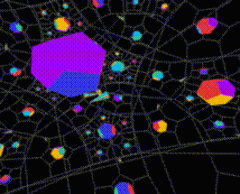Mathenautics: Three-Eighths of Thurston’s Eight-Fold Way
November 1st, 1992 - November 1st, 1993
Categories: Applications, Supercomputing, Visualization

About
Mathematicians study the behavior of lines and curves on the surfaces of different shapes, such as a sphere and a donut-shaped torus. While these bodies are 3D, their surfaces are 2D manifolds. Examples of 2D manifolds that are not surfaces of 3D bodies are the plane, the saddle and the Moebius band. With an accompanying geometry, mathematicians can measure distances, angles and areas in these 2-spaces. Different 2-spaces admit different geometries. On a plane in 3-space, the three angles of a triangle always add up to 180 degrees, whereas on a sphere, this sum is always greater than 180 degrees. Inside the hole of a torus, on the part of the surface facing the center, this sum is always less than 180 degrees, whereas outside, on the part facing away, it is always greater than 180 degrees.
If, unlike the torus, the geometry is to be uniform over an entire space, then for surfaces, there are only three different geometries possible:
- The familiar Euclidean (the geometry of the surface of a plane)
- The spherical (the geometry of the surface of a sphere)
- The hyperbolic (the geometry at the center of a saddle)
Mathematician William Thurston conjectured in 1980 that, for 3D manifolds, there are eight different uniform geometries - his eight-fold way. People are used to seeing 2-spaces from the outside, as illustrations that appear in math texts. The CAVE enables participants to see 3-spaces for three of Thurston’s eight geometries from the inside, as inhabitants might see them.
Three different 3-spaces can be visited in the CAVE: Euclidean, spherical and hyperbolic. Each is represented by packing, or tiling, the space by repeating a simple shape. Two instances of Euclidean 3-space can be visited: one is tiled by cubes; the other, nicknamed Escher space because of its resemblance to Escher’s “Relativity,” is tiled by staircases. The spherical and hyperbolic 3-spaces are tiled by dodecahedra, but in distinctly different ways.
Non-Euclidean geometries, historically taught and appreciated solely in the abstract, may now be lived in and experienced through the use of the CAVE. The main thrust of this application is to test virtual reality as an educational tool in a significant context, one that is not simply derivative of previous techniques, but which uses the virtual reality medium to its potential.
This application was a part of Experiential Science in The Virtual Reality Theater venue at Supercomputing ’93